Montana IPM Bulletin, Spring 2019

The Montana IPM Bulletin presents critical pest management and pesticide education articles for Montana homeowners, pesticide applicators, farmers and ranchers. These articles are designed to deliver timely updates from an unbiased perspective that are specific to Montana. This is a cooperative effort between Montana State University pesticide education and integrated pest management programs.
Contents
- Management of Wireworms: Present Status
- MSU Extension Pesticide Education Program Recognizes Two Trainers for Statewide Impacts
- Kochia and Russian Thistle: Omnipresent Weeds that will Only Get Tougher to Control
- Evaluating a New Herbicide for Controlling Grasses in Non-Crop Areas
- Pest Management Toolkit
- Ask the Expert
- Meet Your Specialist: David Wheeler
- Acknowledgments
PDF links can be viewed with Adobe Acrobat or Sumatra PDF.
Management of Wireworms: Present Status
Anamika Sharma, Ramandeep Kaur Sandhi, and Gadi V.P. Reddy, Montana State University Western Triangle Agricultural Research Center
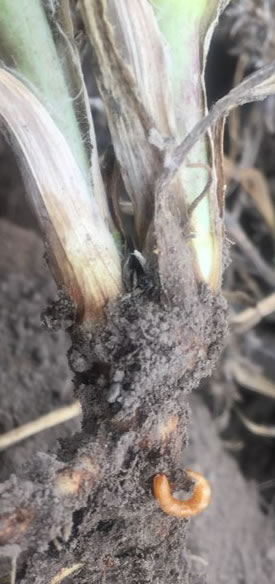
Wireworm damage to a wheat plant.
Photo by Anamika Sharma.
Wireworms pose a major threat to spring wheat crops in Montana. Presence of these soil-dwelling larvae of click beetles is tough to predict and manage in any field. Fields with a prior history of wireworms should always be checked for outbreaks. In spring, click beetles mate and lay eggs in the soil. After hatching, wireworms start feeding on germinating seeds and stems of emerged plants. This damage occurs in patches. Wireworms live in the soil for several years, however, life-span depends on the species. During the colder season, wireworms burrow deeper to avoid frozen soil, and during the warmer season, they come closer to the soil surface to feed. It has been reported that more than 800 species of wireworms are found in North America. In the Golden Triangle Area of Montana, three species are dominant: Limonius californicus, Hypnoidus bicolor and Aeolus mellillus. Differences in the lifecycle of different species of wireworms make predicting outbreaks difficult. Wireworms in Montana prefer wheat and barley crops, however wireworms can survive on several crops. Soil moisture, temperature, and species play an important role in the population dynamics of wireworms.
Correct scouting is necessary to manage wireworms. Stocking traps with wheat and barley seeds soaked in water for 24 hours are used to assess wireworm densities and assess how plentiful they are. Soaking seeds in water assists in seed germination, thus releasing CO2 which attracts wireworms. Traps should be buried in about 6-inch- deep holes and covered with soil and black plastic to provide an environment amenable for wireworms. The traps are removed in about 10-15 days. A minimum of one trap per acre is required to assess the population of wireworms. The threshold for treatment is one wireworm per trap. This assessment should be done three to four weeks before planting.
The best option available for managing wireworms is treating seeds with neonicotinoids (imidacloprid, clothianidin, and thiamethoxam). However, the application of a seed treatment causes prolonged wireworm intoxication, and hence only temporarily repels wireworms and does not provide complete control. Cultural management of wireworms includes seeding at a depth of 1-1.5 inches for quick emergence of seedlings and crop rotation with non-grain crops which helps break the life cycle of wireworms.
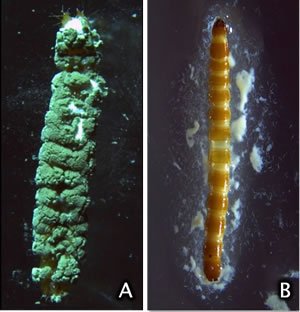
FIGURE 1. A. Wireworms killed by entomopathogenic fungus (EPF) in laboratory conditions; B. Wireworms killed by entomopathogenic nematodes (EPN) in laboratory conditions. Photo A by Anamika A B Sharma; B by Ramandeep Kaur Sandhi
At the Western Triangle Agricultural Research Center near Conrad, methods to manage wireworms by using biological and cultural controls are being evaluated. As cultural control, we have been testing the use of trap crops since 2015. Our study shows that pulse crops can be used to divert wireworms away from spring wheat. Peas and lentils, if planted in a specific arrangement with the wheat crop, can work as a trap crop to attract wireworms. We are exploring various designs such as border and row planting of pulse crops with the wheat crop. Since pulse crops are used increasingly across Montana, this tool may be a viable option, offering increased profits compared to conventional approaches. As biological control, we are testing entomopathogenic fungi (EPF) (provided by Dr. Stefan Jaronski, USDA- ARS) and entomopathogenic nematodes (EPN) (provided by Dr. David Shapiro llan, USDA-ARS). We are testing various strains of Metarhizium spp. and Beauveria bassiana, where these EPFs are applied in granular form on polenta, millet, and couscous as carriers. When applied in furrows with seeds, these fungal granules are effective in managing wireworms and provide an environmentally-safe option. We are further testing the most effective carrier of these fungal strains and their cost efficacy to apply them in wheat crops in Montana. In 2017 and 2018, we tested five EPFs (B. bassiana GHA, B. bassiana ERL836, M. robertsii DWR356, M. robertsii DWR2009, and M. brunneum F52) on polenta, millet, and couscous granules. Our results indicated that in irrigated and dryland fields, the efficacy of EPFs varied. Overall, B. bassiana GHA, B. bassiana ERL836 and M. robertsii DWR 2009 on millet were found to be effective. Cost-benefit ratio analysis indicated that the use of these EPFs is more costly than using neonicotinoids as a seed treatment. However, further work is required and under progress to reduce the production cost of EPF granules. Similarly, 10 different EPN strains (species of Steinernema and Heterorhabditis) are being tested. Some of them are commercially available. These EPNs are initially being evaluated in laboratory bioassays and later they will be tested in greenhouse and field conditions. As of now S. carpocapsae and S. rarum are effective against wireworms based on greenhouse studies.
MSU Extension Pesticide Education Program Recognizes Two Trainers for Statewide Impacts
Cecil Tharp, MSU Pesticide Education Specialist
The Montana State University (MSU) Pesticide Education Program (PEP) recognized two individuals for exceptional efforts that benefit pesticide applicators across Montana. The MSU PEP offers guidance to pesticide applicators across the state, while coordinating the certification and training of approximately 5,600 certified farm (private) applicators across Montana. The program delivered an early achievement award to Kari Lewis, Glacier County Extension Agricultural/4-H Agent, and lifetime achievement award to Dave Brink, Mineral County Extension Agricultural/4-H Agent.
The MSU PEP early achievement award is given to individuals demonstrating exceptional efforts and impacts in pesticide education over the first five years with the university. Kari Lewis, originally from Kevin, MT, was hired as an MSU Extension Agricultural/4-H Agent in May 2014. Since her hire, Lewis has developed presentations on reading and understanding the pesticide product label and managing spotted knapweed; delivered presentations at train-the-trainer programs; contributed to multiple weed management guides; and assisted many other pesticide trainers in delivering local pesticide programs. Lewis has proven herself a leader in pesticide education with her continued involvement in pesticide programs across north-central Montana. She has served in key roles with the state 4-H Livestock Committee, while locally active with the Glacier County Conservation District, Cut Bank Community Garden, Cut Bank Trails and Marias Fair livestock committee. It is exceptional for new MSU Extension agents to deliver high pesticide education impacts so early in their career.
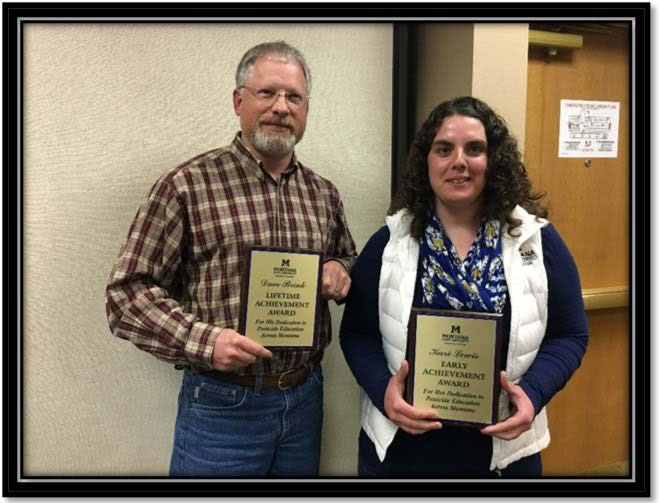
FIGURE 2. Dave Brink and Kari Lewis receiving their Pesticide Education Program Achievement awards. Photo by Cecil Tharp.
The MSU PEP lifetime achievement award is delivered to an individual demonstrating exceptional efforts resulting in statewide pesticide education impacts over a minimum of 15 years. Dave Brink was born and raised in Wyoming and received a B.S. in Fish and Wildlife Management from Utah State University in 1993. He was hired as the Mineral County Weed Coordinator in 1997 and the MSU Extension Agricultural / 4-H Agent in 2004, working both jobs simultaneously since that time. Brink developed many presentations on the highly technical subjects of calibration, understanding pesticide equipment and hosting spray days. These presentations are used continually by other pesticide trainers across Montana. Due to the effectiveness of his presentation delivery, Brink is frequently invited to deliver presentations at county weed district, county Extension, Montana Department of Agriculture, and U.S. Forest Service pesticide programs. He also serves on many committees that benefit Montana pesticide applicators, including 15 years on the board of directors for the Montana Weed Control Association and serving as the MSU Pesticide Education Program district 1 (Northwestern MT) advisory panel member since 2010. Many of his ideas have led to improvements in the Montana Private Applicator Program that benefit 5,600 private applicators and 56 county pesticide trainers. Finally, Brink’s involvement as a leader/speaker at numerous statewide PEP train-the-trainer programs is invaluable to Montana private applicator trainers.
For Further Information
Navigate to the MSU Pesticide Education Program homepage. Nominees for future pesticide education awards may be sent to Cecil Tharp, Pesticide Education Specialist (406-994-5067; [email protected]).
Kochia and Russian Thistle: Omnipresent Weeds that will Only Get Tougher to Control
Tim Seipel, Extension Cropland Weed Specialist
Kochia (Kochia scoparia or also Bassia scoparia) and Russian thistle (Salsola kali) are the most problematic broadleaf weeds in Montana cropping systems. Over the last 70 years, but especially after the transition to no-till, these weeds have been managed using herbicides, however evolved herbicide resistance is making management harder. Herbicide resistance is the ability of a plant to tolerate an herbicide that once controlled it. Unfortunately, managing kochia and Russian thistle will only get tougher in the Northern Great Plains as many populations are resistant to commonly-used herbicides. In Montana and adjacent Alberta, populations of both species have been confirmed to be resistant to glyphosate (group 9) and ALS inhibitor (group 2) herbicides, and the frequency of herbicide- resistant populations is increasing.
Kochia
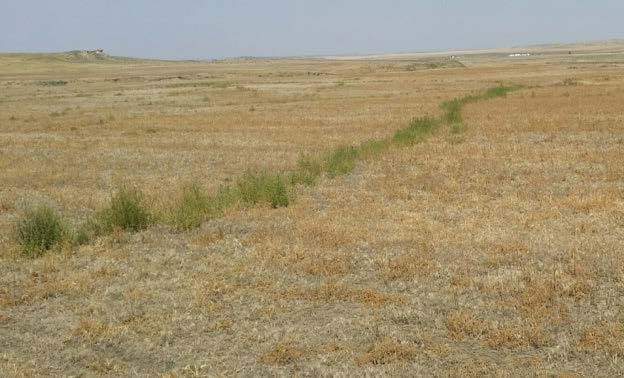
FIGURE 3. A glyphosate resistant kochia plant dispersed its seeds by tumbling in the wind, resulting in resistant offspring growing in a strip in a field in Montana. Photo credit Eric Miller.
In 2012 a survey of kochia in Alberta revealed that most glyphosate-resistant kochia was found in chemical fallow cropping systems. More follow-up surveys have identified other populations that are resistant to both ALS (group 2) and glyphosate (group 9). In 2017 in southern Alberta, Agriculture and Agri-Food Canada surveyed populations again and found glyphosate-resistant kochia in 15 of 16 municipal districts, while in 2012 it was only found in 3 of 16. They found 40% of populations had glyphosate resistance and approximately 40% of individuals in those populations were glyphosate resistant. These results underscore how fast herbicide resistance spreads. In Montana and Alberta most populations of kochia are resistant to group 2 ALS herbicides, and glyphosate resistance will also continue to spread.
What was also worrying about results from the 2017 survey was that resistance to dicamba (group 4) was found at almost 10% of sites. While this level of resistance is currently relatively low, it is concerning as the pattern suggests the frequency of dicamba resistance will increase as we are in the early stages of resistance evolution. Triple-resistant group 2 + group 9 + group 4 kochia was identified in 10% of populations sampled in southern Alberta. Evolution of group 4 resistance is alarming because we rely heavily on group 4 herbicides for control in wheat, and group 4 resistance will limit herbicide choices even more.
Russian thistle
Evolution of herbicide resistance in Russian thistle is also widespread in Montana, especially to group 2 herbicides, though evolution of resistance has been slower than in kochia. The first documented case of resistant Russian thistle in Montana occurred in 1987 to chlorsulfuron, an early ALS inhibitor (group 2) herbicide. In 2015, glyphosate-resistant Russian thistle was documented in Montana. In the 2017 survey in Alberta, group 2 resistant Russian thistle was found in 62% of populations in most municipal districts in southern Alberta. Russian thistle resistance is expected to increase quickly, and we should be on the lookout for more resistance.
What do we do? For both species we need a concerted effort by all stakeholders to manage these herbicide resistant weed populations. Best management practices can be utilized to slow the spread of these herbicide resistant weeds. Understanding the biology of the weeds can provide a strategy to exploit the species’ weakness. Maintain clean equipment and be cognizant of what is growing around the equipment. Reduce spread of seed, scout for plants that were not killed during herbicide applications and remove them. Use integrated weed management that includes cultural and mechanical weed control techniques. Have a diverse crop rotation, use different herbicide modes of action, and vary control techniques. In other words - keep the weeds guessing. The more predictable our management, the easier it is to evolve resistance to a single practice. For more information, consult MontGuides produced by Montana State University Extension, including Managing Herbicide Resistant Kochia [link has expired].
Evaluating a New Herbicide for Controlling Grasses in Non-Crop Areas
Audrey J. Harvey and Dr. Jane Mangold, Montana State University, Department of Land Resources & Environmental Sciences
Herbicides can be a useful tool for controlling invasive annual grasses like cheatgrass (Bromus tectorum) and ventenata (Ventenata dubia). Presently, herbicides control winter annual grasses for one or sometimes two years with minor injury to resident, desirable plants. A new herbicide that may enable longer-term control in non-crop and natural areas is indaziflam (Esplanade® 200 SC, Bayer CropScience LP). Indaziflam is a cellulose biosynthesis inhibiting herbicide, meaning it has activity on the cellular structure of plant roots. Applied prior to seedling emergence, it stops the growth of roots that emerge from the seed. While non-selective, it appears to have more activity on monocots than dicots and may control annual grasses for up three years, however these effects in the field are not yet thoroughly known. Fall applications in northern Colorado provided 83-100% control of cheatgrass three years after treatment; this was compared to the more commonly used herbicides glyphosate, imazapic, and rimsulfuron, whose effectiveness dropped from about 80% in the first year after treatment to 30% by the third year.
We evaluated the efficacy of indaziflam compared to other commonly-used annual grass herbicides for controlling the new invader ventenata in a smooth brome (Bromus inermis) dominated pasture near Bozeman, Montana. Ten herbicide treatments were applied post-emergence in early November 2016. Our treatments included a non-sprayed control, indaziflam (Esplanade 200 SC, Bayer CropScience LP), propoxycarbazone- sodium (Lambient™, Bayer CropScience LP), rimsulfuron (Matrix SG, DuPont), imazapic (Plateau, BASF Corporation), glyphosate (Accord XRT II, Dow AgroSciences LLC), and indaziflam combined with each of the other four active ingredients (a.i.). We assessed ventenata control and injury to non-target species three times throughout each of the 2017 and 2018 growing seasons.
In addition to annual grass control, we were also interested in plant community responses to the 10 treatments over the two growing seasons because promoting desired, competitive vegetation should be the goal of invasive plant management. Canopy cover and biomass of ventenata, annual forbs, perennial grasses, and perennial forbs were measured to determine impacts of indaziflam to the local plant communities.
Ventenata Control
Compared to the other treatments, indaziflam applied alone or in combination with the other herbicides provided the highest ventenata control at 8, 11, 20, and 23 months after treatment (Note: Assessments made at 8 and 20 months after treatment corresponded to mature ventenata; assessments made at 11 and 23 months after treatment were made to ventenata seedlings). In particular, the indaziflam- combination treatments provided the most consistent control, ranging from 89 – 100% over the course of the study. The indaziflam-alone treatment varied across time but remained one of the most effective at 76% control 23 months after treatment. Because ventenata is a winter annual grass that emerges in the fall, we expect the high control ratings at 23 months after treatment (fall 2018) to be reflective of summer 2019 (approximately 32 months after treatment), in which case treatments containing indaziflam will provide a third year of ventenata control. Propoxycarbazone-sodium, rimsulfuron, and imazapic treatments all tended to decrease in effectiveness over the course of the study. While these herbicides provided about 60-90% control 8 months after treatment, they were no different from the non-sprayed control 23 months after treatment. The most obviously ineffective treatment was glyphosate, which showed no control of ventenata for all months of evaluation.
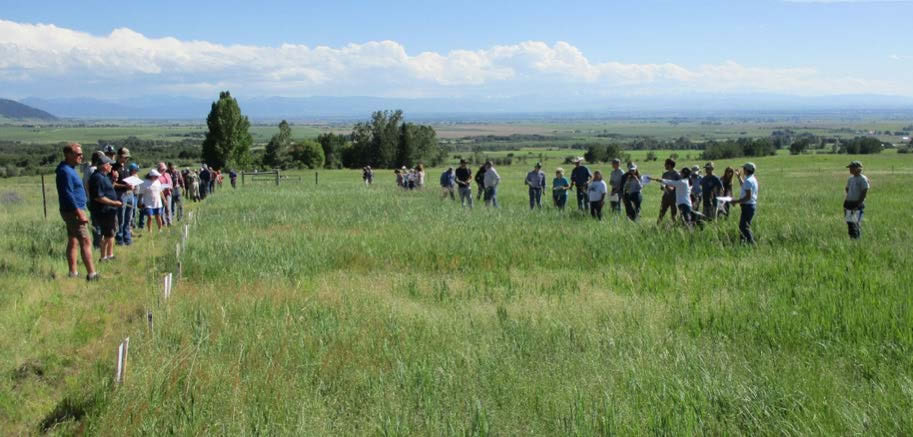
FIGURE 4. Field tour held at site of ventenata herbicide trial in Gallatin County, June 2018. Photo by Stacy Davis.
Plant Community Composition
In general, herbicide treatments had minimal negative impacts to species diversity
at the site. In fact, in many cases species richness increased from 8 to 20 months
after treatment. Interestingly, species richness also increased in the non-sprayed
control, which demonstrates that plant community composition varies from year to year.
By including the non-sprayed control when assessing herbicide efficacy, we were able
to better distinguish herbicide effects from annual variability. During this study,
spring 2018 was cooler and wetter than spring 2017 and may have also affected plant
community composition. In terms of plant biomass injury, there was no difference in
annual and perennial forb biomass across treatments. The glyphosate treatment had
the most ventenata growing as compared to all other treatments, and no discernable
treatment differences were found for perennial grass biomass.
Invasive winter annual grasses are notorious for growing across a wider range of seasons
than native perennial grasses due to their ability to germinate and grow at low temperatures.
While this extended growing season can provide an advantage for annual grasses, it
also presents an opportunity for selective chemical control that targets newly germinated
seedlings. In this study we showed that indaziflam may expand our herbicide options
in managing winter annual grasses with up to three years of control. Indaziflam persists
in the soil for multiple years, a desirable trait for depleting the seed bank of invasive
winter annual grasses; but continued research is needed on how plant communities respond
to indaziflam treatments, particularly for perennial grasses as they share the most
similar biology with annual grasses.
Esplanade 200 SC (a.i. indaziflam) is not currently labeled for use in areas where
domestic livestock grazing occurs, but it is under review by the Environmental Protection
Agency (EPA) and may have a rangeland and pasture label in 2020. Montana, Wyoming,
and Utah have a Section 18 Specific Exemption emergency use label to apply Esplanade
200 SC for control of ventenata and medusahead (Taeniatherum caput-medusae) on rangeland, pastures, and Conservation Reserve Program (CRP); in such cases, livestock
must be excluded from a sprayed area for two weeks after application. Herbicide alternatives
for use on ventenata in range and pasture include: Axiom DF (a.i. flufenacet), Osprey
(a.i. mesosulfuron- methyl), Sinbar WDG (a.i. terbacil), Plateau or Panoramic (a.i.
imazapic), and Outrider (a.i. sulfosulfuron).
Pest Management Toolkit
On June 18th -19, 2019, the integrated pest management team at Montana State University will host a workshop on integrated management of weeds. The two-day workshop will focus on managing weeds in croplands and will include hands-on activities and discussions on integrated weed management. Topics include managing weeds in cereal cropping systems, herbicide resistance prevention and research, understanding non-target herbicide injury prevention and diagnosis, and use of cover crops to manage weeds. For more information and to register, visit the IPM 2019 Workshop page.
Level 2 Noxious Weed Management Workshop
- September 10-12, 2019, at the C’Mon Inn in Bozeman. Contact Jane Mangold at [email protected] for more information.
New Fact Sheets on Noxious Weeds
- Rush Skeletonweed (968KB PDF)
- Rush skeletonweed is an invasive, non-native perennial forb that can negatively impact range and crop lands. Rush skeletonweed’s presence is limited in Montana so efforts should focus on early detection and rapid response to contain and control reported infestations.
- by Stacy Davis, Research Associate; and Jane Mangold, Associate Professor and Extension Invasive Plant Specialist, Department of LRES
- Dyer’s Woad (1.15MB PDF)
- Invasive plants such as dyer’s woad may degrade plant communities and reduce suitable habitat for livestock and wildlife. This plant has limited distribution in Montana, and early detection and eradication are management priorities. Contact your local Extension agent or weed coordinator for more information.
- by Noelle Orloff, Associate Extension Specialist; and Jane Mangold, Extension Invasive Plant Specialist, Dept. of Land Resources and Environmental Sciences
- Field Bindweed (1.03MB PDF)
- Field bindweed is a persistent, perennial noxious weed that has an extensive root system and long-lived seeds. It has a twining growth habit that can interfere with harvesting in crop fields and it is difficult to control in turfgrass and natural areas.
- by Stacy Davis, Research Associate; and Noelle Orloff, Associate Extension Specialist, Department of Land Resources and Environmental Sciences
- Managing Weeds on Small Acreages in Montana (26MB PDF)
- A new publication from MSU Extension. This booklet provides the foundation for developing a weed management plan by explaining basic concepts and practices of vegetation management.
- by the Montana Noxious Weed Education Campaign, revised and updated in 2018 from the original publication titled, TIPS for Fighting Weeds on Small Acreages in Montana, printed in 2007 by the Montana Department of Natural Resources and Conservation Service, Helena, Montana. Design and layout by MSU Extension Publications.
Ask the Expert
Q. Is prescribed fire a good way to control leafy spurge?
Jane Mangold says: Fire can kill leafy spurge seeds, particularly under conditions where the fuel load is high (e.g. lots of dried vegetation). Like other invasive plants, though, leafy spurge produces a lot of seeds, so a single prescribed fire is unlikely to control leafy spurge. In addition, fire can stimulate growth from roots, and because leafy spurge has a robust root system, fire is typically not viewed as a viable option for leafy spurge control. Fire can enhance performance of other leafy spurge control tools, though (e.g. herbicides, biological control insects), and if used, should be integrated with other control methods.
Q: Could an herbicide resistant weed become susceptible to an herbicide again or will it always be resistant?
Tim Seipel says: The short answer is yes it could become susceptible again, but not in (y)our lifetimes, and especially not if you continue to apply the same herbicide. The long answer is these are complex interactions. Evolved herbicide resistance is driven by three things: selection for resistant genotypes driven by herbicide selection, gene flow within a population through seed dispersal and pollination, and the fitness penalty a weed incurs for evolving herbicide resistance. I think about genes as if they are in a big pool sloshing around and mixing. There will be multiple genotypes on the landscape - the landscape is the pool. Both resistant genotypes and susceptible genotypes will be present at one time in the pool. The more selection you put on a population with one herbicide (or mode of action), the more the mix will consist of the resistant genotype, but gene flow from the roadside or non-treated areas could slosh the pool back towards being a mix containing a susceptible genotype, especially if there is a fitness cost to resistance.
A fitness cost or penalty can be thought of as the price a genotype pays in its growth due to being resistant. For example, a resistant genotype may be shorter or produce fewer seeds than a susceptible genotype. If the fitness cost is minimal and you continue use of the same herbicide, then at some point the resistant genotype dominates the pool, and the resistance is here to stay. Hence, preventing the spread of resistant genotypes is critical, and that is best accomplished by using different selection pressures (different weed management types or, at a minimum, different modes of action), and by identifying and removing plants with resistant genes from the pool.
Q. If I already have a license for restricted use herbicides, do I need additional training for using paraquat products?
Cecil Tharp says: Maybe. Additional training is dependent on the paraquat product label language, which is changing in 2019 to include paraquat trainings. All paraquat labels distributed by manufacturers will be updated to include mandatory paraquat trainings by the fall of 2019, however dealer stocks vary. Applicators purchasing paraquat products in 2019 should be looking for this training requirement. Individuals purchasing paraquat products with new training requirements must attend an EPA approved paraquat training prior to mixing, loading, or applying. An online paraquat training, created by pesticide manufacturers and approved by the EPA, is available online at https://campus.extension.org/ enrol/index.php?id=1660. This training provides information about paraquat’s toxicity, personal protective equipment, new label requirements, restrictions, and the consequences of misuse. Applicators using or purchasing paraquat products with old product label language (not including paraquat trainings) are not required to take the additional trainings.
See the MSU pesticide news release.
Meet Your Specialist
David Wheeler, Extension Plant Pathologist, Montana State University

What is your field of interest (scholastic and research)?
I was trained in plant pathology, mycology, evolutionary biology, and statistics. I am especially interested in the history of and relationships between fungi and plants. Fungi contribute to and jeopardize the health of the plants on which we depend. My goal at Montana State University is to minimize the impacts of plant diseases on pulses, potatoes, and sugarbeets. sugarbeets.
What are some important areas of focus in your field?
Pulses, potatoes, and sugarbeets are all negatively impacted by plant diseases. Short- and long-term management strategies are needed to help growers mitigate losses. For each crop, pathogens that reside in soil and/or are aerially-dispersed are problems in Montana. For example, root diseases of pulses and sugarbeets and Potato Virus Y (which is spread by aphids) of potatoes are economically important diseases in Montana. Since soilborne diseases tend to be caused by organisms that survive for extended periods of time, these diseases are perennial problems for growers, and will therefore be the subject of most of my research and Extension efforts.
Describe some past research projects
Together with my advisor at WSU, Dr. Dennis Johnson, I documented the effects of crop rotation on the emergence and evolution of a fungus, called Verticillium dahliae, from wilted potatoes to symptomless rotation crops. In collaboration with scientists at Oregon State University, I applied artificial intelligence models to predict wilt of mint crops from a number of biotic and abiotic factors. I also documented several interactions between fungi within the same species that result in different levels of disease and genetic changes in the fungus. In response to grower requests, I also characterized a new disease of sunflower and potatoes and described how pathogens change their ability to cause disease over time. Finally, scientists at OSU and myself are describing how plants respond to fungal infection at the molecular level.
What are some of your current projects?
Currently, I am writing and submitting proposals for a couple collaborative projects at MSU. For example, in collaboration with Dr. Nina Zidack, we plan to identify the climatic variables that influence late blight epidemics in western Montana potato fields. Also, in collaboration with Drs. Bright Agindotan and Alan Dyer, we plan to develop a diagnostic tool that can identify fungal pathogens from pictures with artificial intelligence tools. Finally, I am on the lookout for new projects that satisfy the needs of growers in Montana state.
What projects would you like to focus on in the future?
For the future, my first goal is to identify the needs of growers in Montana. After this, I will partner with stakeholders, Extension agents, and other researchers at MSU, and use my Extension appointment to inform research projects that deliver solutions to growers. More specifically, I am very interested in leveraging knowledge about pathogen biology to solve short- and long-term disease management problems for pulses, potatoes, and sugarbeet growers in Montana.
How can farmers use your research to their benefit?
Ultimately, if the above projects are funded, we will develop a disease-warning system to guide fungicide application for potato growers in Montana. Additionally, we will develop a tool to help diagnosticians identify plant pathogens and inform disease management decisions for growers.
Where are you from originally?
I was born and raised in southeastern Pennsylvania, in a town called Lebanon.
Where/when did you receive your degrees?
I received a B.S. in Horticulture with a minor in Fine Arts from Temple University in 2011. Thereafter, I moved west to pursue a M.S. and Ph.D. in Plant Pathology from Washington State University (WSU) in 2015 and 2018, respectively. During my graduate studies I became very interested in statistics, so I obtained a Minor in Statistics from WSU as well.
Where have you worked/taught in the past?
I just finished my Ph.D. at WSU. This is my first job aside from serving as a teaching assistant for numerous classes and working at gardens, farms, and arboreta as an undergrad.
What do you like to do in your spare time?
Any hobbies or additional activities? Anything outside that does not require lots of equipment. For example, I like walking, hiking, running, swimming, cycling and probably skiing (I have not yet tried in earnest). I also like reading, writing, gardening, playing music, taking pictures, and spending time with friends and family. I also enjoy writing and computer programming from cafés.
Acknowledgments
Do You Have a Question or Comment Regarding the Montana IPM Bulletin?
Send inquiries and suggestions to:
Cecil Tharp
Pesticide Education Specialist
P.O. Box 172900
Montana State University
Bozeman, MT 59717-00
Phone: (406) 994-5067
Fax: (406) 994-5589
Email: [email protected]
Web: pesticides.montana.edu
Jane Mangold
Invasive Plant Specialist
P.O. Box 173120
Montana State University
Bozeman, MT 59717-3120
Phone: (406) 994-5513
Fax: (406) 994-3933
Email: [email protected]
Web: landresources.montana.edu
Noelle Orloff
Associate Extension Specialist
P.O. Box 173120
Montana State University
Bozeman, MT 59717-3120
Phone: (406) 994-6297
Fax: (406) 994-3933
Email: [email protected]
Web: diagnostics.montana.edu

Common chemical and trade names are used in this publication for clarity by the reader. Inclusion of a common chemical or trade name does not imply endorsement of that particular product or brand of herbicide. Recommendations are not meant to replace those provided in the label. Consult the label prior to any application.
Original 2019 PDF (1.1MB)
